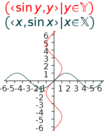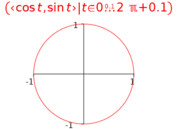7.5 Parametric Equations
The coordinates of points that make up a curve can be defined by two expressions that depend on the same parameter.
For example, the parametric equation of a circle is given by the equations 

In Myron, a parametric sequence of points is defined by a tuple generator. The generator template consists of a point expression whose components capture the substance of parametric equations. The parameter is then bound to the generator's domain variable. If the generator domain is an interval expression whose limits are in turn bound to variable definitions, the adjusters associated with the variables can be used to control the values supplied to the parametric functions (see §7.5.2).
Exploratory plotting of parametric equations can be performed by situating a simple point expression whose components are single-valued functions as the template of a tuple generator whose domain variable is bound to the X-axis. Manipulating the extremities of the X-axis focuses the interval being plotted. These ideas are explored in §7.5.1
A simple point expression whose components are constant expressions is plotted as a position vector.
7.5.1 Simple Parametric Graph
The simple function




An axis domain only has a value in the context of the plotter. In the workspace, expressions with axis domains
are not evaluable. Both axes are adjustable. To exploit this, an axis domain for the Y-axis is also available.
For example, the parametric sequence 



7.5.2 Parametric circle
The parametric graph of a circle is given by plotting





